

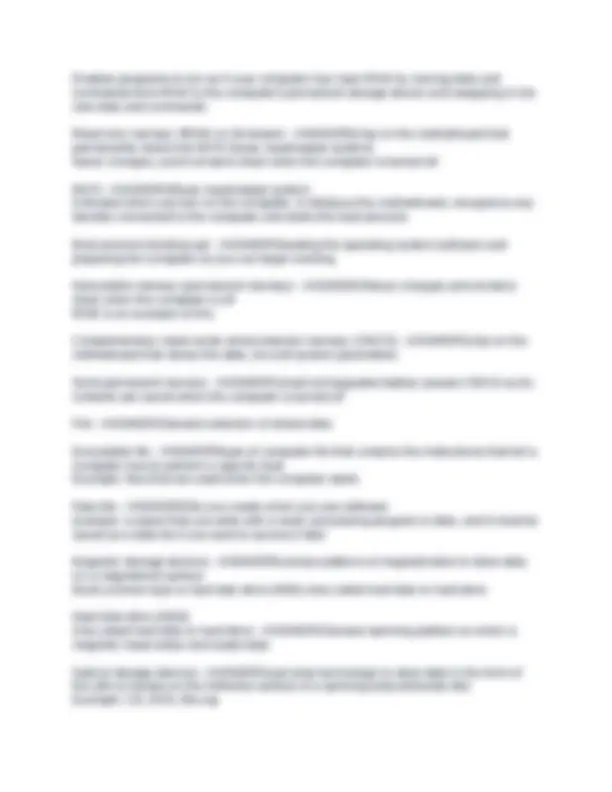
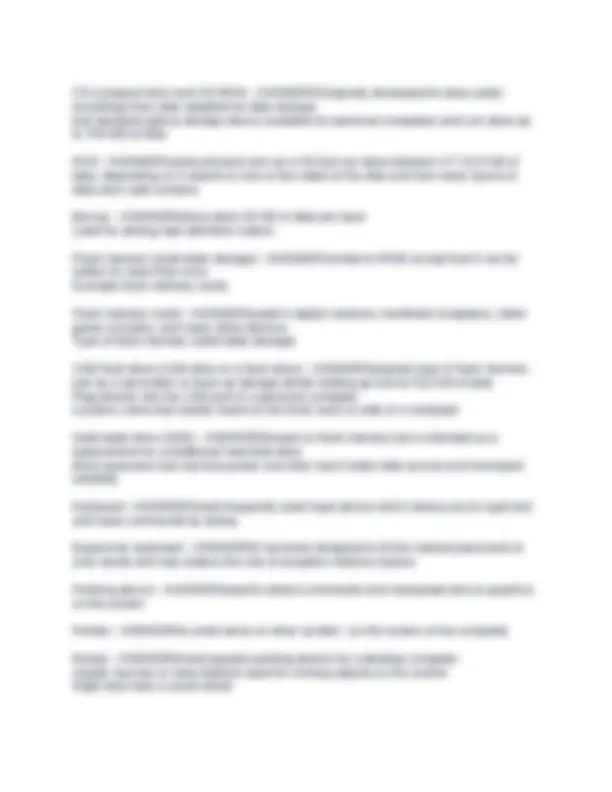
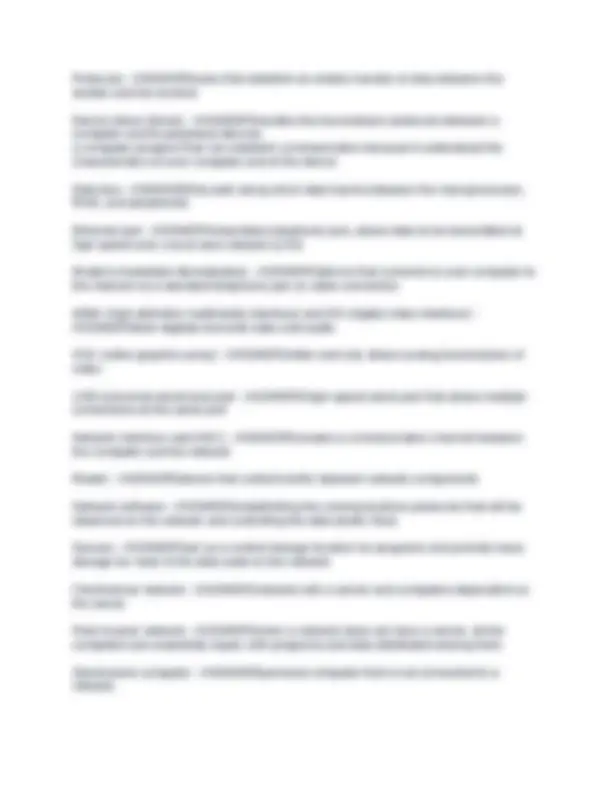
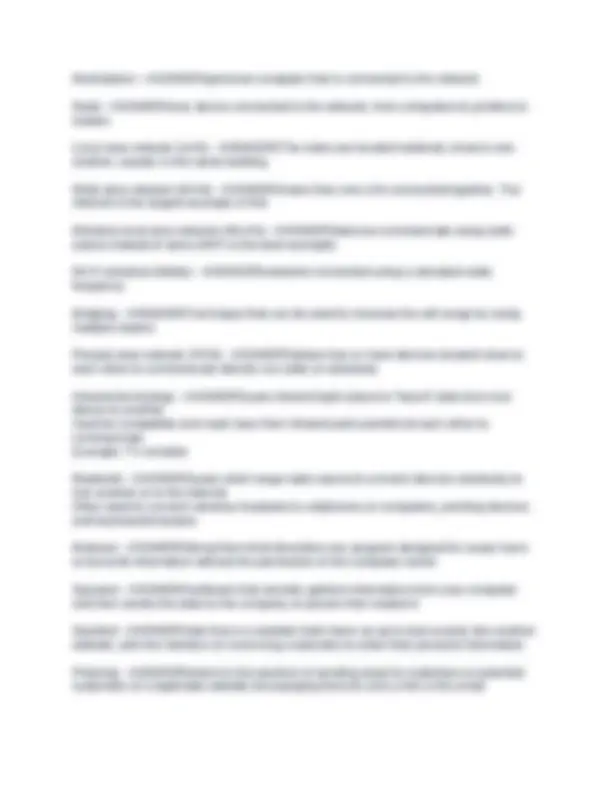
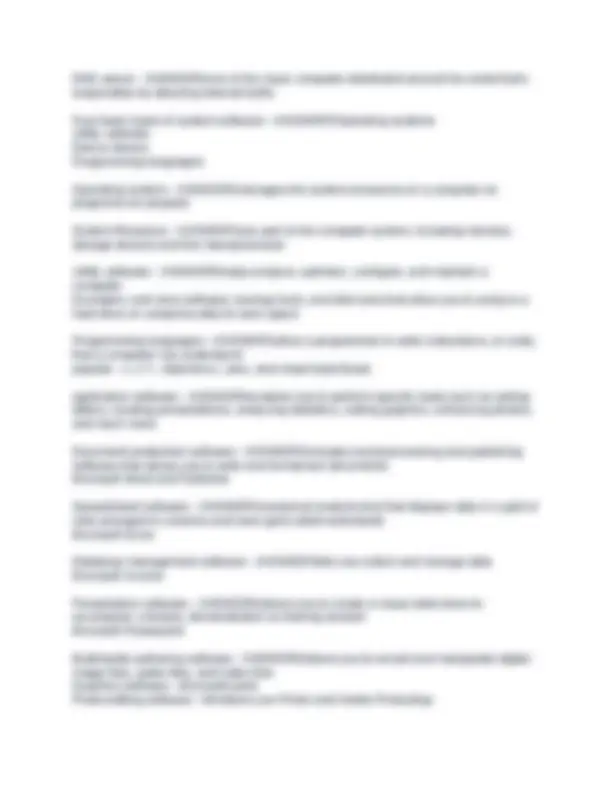


Study with the several resources on Docsity

Earn points by helping other students or get them with a premium plan


Prepare for your exams
Study with the several resources on Docsity

Earn points to download
Earn points by helping other students or get them with a premium plan
Community
Ask the community for help and clear up your study doubts
Discover the best universities in your country according to Docsity users
Free resources
Download our free guides on studying techniques, anxiety management strategies, and thesis advice from Docsity tutors
CGS1060- Module 1 Questions with Verified Answers
Typology: Exams
1 / 11

This page cannot be seen from the preview
Don't miss anything!







Personal Computers - ANSWERStypically used by a single user at home or in the office used for general computing tasks such as word processing, manipulating numbers, working with imagines or video, exchanging email, and accessing the internet. Desktop computers - ANSWERSdesigned to remain in one location and require a constant source of electricity Laptop computers - ANSWERShave a hinged lid that contain the computers display and a lower portion that contains the keyboard powered by rechargeable batteries and easily slip into a bag or briefcase Notebook computers - ANSWERSvery similar to laptop computers but are generally smaller and less powerful Subnotebook computer (ultraportable computers or netbooks) - ANSWERSvery small and light, and are primarily designed to allow users to access the internet and check email Tablets - ANSWERSthin computer that do not have an external keyboard or mouse touch screen or uses a stylus ideal for surfing the web, checking email, reading electronic books, watching video, and creating artwork Handheld computers - ANSWERSsmall computers that usually have more limited capabilities than traditional PCs Personal Computers (PCs) - ANSWERSDesktop computer Laptop computer Subnotebook computer Tablets Handheld computers - ANSWERSSmartphones MP3 players
Smartphones - ANSWERSused to make and receive phone calls, maintain an address book and calendar, send email, connect to the internet, play music, and take photos or video Can also perform some of the same functions as a traditional PC, such as word processing MP3 players - ANSWERSstore and play music some models used to play digital movies or television shows Mainframe computers (supercomputers) - ANSWERSused by large business, government agencies, and in science and education. Provide centralized storage and processing, and can manipulate tremendous amounts of data Computer system - ANSWERScomputer hardware and software Hardware - ANSWERSphysical components of a computer Software - ANSWERSintangible components of a computer system, particularly the programs, or data routines, that a computer uses to perform a specific task. Configuration (architecture) - ANSWERSdesign and construction of a computer Example Specifications - ANSWERStechnical details about each hardware component Example Data - ANSWERSrefers to the numbers, words, figures, sounds, and graphics that describe people, events, things, and ideas Processing - ANSWERSModifying data Processing tasks occur on the - ANSWERSMotherboard Motherboard - ANSWERSMain electronic component inside the computer Circuit board - ANSWERSa rigid piece of insulating material with circuits Circuits - ANSWERSelectrical paths that control specific functions Motherboards contain the following processing hardware: - ANSWERSMicroprocessor (processor, central processing unit (CPU) Cards Microprocessor (processor, Central processing unit (CPU)) - ANSWERSconsists of transistors and electronic circuits on a silicon chip.
Enables programs to run as if your computer has more RAM by moving data and commands from RAM to the computer's permanent storage device and swapping in the new data and commands Read-only memory (ROM) or (firmware) - ANSWERSchip on the motherboard that permanently stores the BIOS (basic input/output system) Never changes, and it remains intact when the computer is turned off BIOS - ANSWERSBasic input/output system Activated when you turn on the computer, it initializes the motherboard, recognizes any decides connected to the computer and starts the boot process Boot process (booting up) - ANSWERSloading the operating system software and preparing the computer so you can begin working Nonvolatile memory (permanent memory) - ANSWERSNever changes and remains intact when the computer is off ROM is an example of this Complementary metal oxide semiconductor memory (CMOS) - ANSWERSchip on the motherboard that stores the date, tim and system parameters Semi permanent memory - ANSWERSsmall rechargeable battery powers CMOS so its contents are saved when the computer is turned off File - ANSWERSNamed collection of stored data Executable file - ANSWERStype of computer file that contains the instructions that tell a computer how to perform a specific task Example: files that are used when the computer starts Data file - ANSWERSfile you create when you use software example: a report that you write with a word- processing program is data, and it must be saved as a date file if you want to access it later Magnetic storage devices - ANSWERSvarious patterns of magnetization to store data on a magnetized surface Most common type is hard disk drive (HDD) also called hard disk or hard drive Hard disk drive (HDD) Also called hard disk or hard drive - ANSWERSSeveral spinning platters on which a magnetic head writes and reads data Optical storage devices - ANSWERSuse laser technology to store data in the form of tiny pits or bumps on the reflective surface of a spinning polycarbonate disc Example: CD, DVD, Blu-ray
CD (compact disc) and CD-ROM - ANSWERSOriginally developed to store audio recordings then later adapted for data storage first standard optical storage device available for personal computers and can store up to 700 MB of data DVD - ANSWERSsame physical size as a CD but can store between 4.7-15.9 GB of data, depending on if stored on one or two sides of the disk and how many layers of data each side contains Blu-ray - ANSWERSdiscs store 25 GB of data per layer Used for storing high-definition videos Flash memory (solid state storage) - ANSWERSsimilar to ROM except that it can be written to more than once Example flash memory cards Flash memory cards - ANSWERSused in digital cameras, handheld computers, video game consoles, and many other devices Type of flash memory (solid state storage) USB flash drive (USB drive or a flash drive) - ANSWERSpopular type of flash memory use as a secondary or back up storage divide holding up one to 512 GB of data Plug directly into the USB port of a personal computer Location varies but usually found on the front, back or side of a computer Solid-state drive (SSD) - ANSWERSbased on flash memory but is intended as a replacement for a traditional hard disk drive More expensive but use less power and offer much faster data access and increased reliability Keyboard - ANSWERSmost frequently used input device which allows you to input text and issue commands by typing Ergonomic keyboard - ANSWERSit has been designed to fit the natural placement of your hands and may reduce the risk of receptive motions injuries Pointing device - ANSWERSused to detect commands and manipulate text or graphics on the screen Pointer - ANSWERSa small arrow or other symbol - on the screen of the computer Mouse - ANSWERSmost popular pointing device for a desktop computer usually has two or more buttons used for clicking objects on the screen might also have a scroll wheel
Display resolution - ANSWERSThe number of pixels the monitor displays in each dimension, typically expressed as width x height Graphics card, also called the a video display adapter or video card, or a built-in graphics processor (built-in graphics card) - ANSWERScontrols the signals the computer sends to the monitor Printer - ANSWERSproduces a paper copy, often called a hard copy, of the text and graphics processed by a computer Dots per inch (dpi) - ANSWERSprinter quality, or resolution, is measured by the number of ______ that a printer can produce. Pages per minute (ppm) - ANSWERSthe speed of a printer is determined by how many ______ it can output LED printers and laser printers - ANSWERSpopular for business use because they product high-quality output quickly and reliably better at producing sharp text and simple graphics than they are at printing clear photographs Inkjet printers - ANSWERSPopular for home and small business use Spray ink onto paper, producing quality comparable to that of a laser printer, though at much slower speeds Speakers (and headphones) - ANSWERSallow you to hear sounds generated by your computer Can be separate peripheral devices, or they can be built into the computer case or monitor Multifunction printer (MFP) - ANSWERSsaves office space by combining several devices into one Can print, scan, copy, and fax documents along with feature camera card reader and photo printing, connect to a network wirelessly Data communications - ANSWERStransmissio n of data from one computer to another or to a peripheral device Sender - ANSWERSthe computer that originates the message Channel - ANSWERSThe message is sent over some type of ___________ such as a telephone or coaxial cable, or wirelessly Receiver - ANSWERSThe computer or device at the messages destination
Protocols - ANSWERSrules that establish an orderly transfer of data between the sender and the receiver Device driver (driver) - ANSWERShandles the transmission protocols between a computer and its peripheral devices a computer program that can establish communication because it understand the characteristics of your computer and of the device Data bus - ANSWERSthe path along which data travels between the microprocessor, RAM, and peripherals Ethernet port - ANSWERSresembles telephone jack, allows date to be transmitted at high speed over a local area network (LAN) Modem (modulator-demodulator) - ANSWERSdevice that connects to your computer to the internet via a standard telephone jack or cable connection HDMI (high-definition multimedia interface) and DVI (digital video interface) - ANSWERSBoth digitally transmit video and audio VGA (video graphics array) - ANSWERSolder and only allows analog transmission of video USB (universal serial bus) port - ANSWERShigh-speed serial port that allows multiple connections at the same port Network interface card (NIC) - ANSWERScreates a communication channel between the computer and the network Router - ANSWERSdevice that controls traffic between network components Network software - ANSWERSestablishing the communications protocols that will be observed on the network and controlling the data (traffic flow) Servers - ANSWERSact as a central storage location for programs and provide mass storage for most of the data used on the network Client/server network - ANSWERSnetwork with a server and computers dependent on the server Peer-to-peer network - ANSWERSwhen a network does not have a server, all the computers are essentially equal, with programs and data distributed among them Stand-alone computer - ANSWERSpersonal computer that is not connected to a network
DNS server - ANSWERSone of the many computer distributed around the world that's responsible for directing internet traffic Four basic types of system software - ANSWERSOperating systems Utility software Device drivers Programming languages Operating system - ANSWERSmanages the system resources of a computer so programs run properly System Resource - ANSWERSany part of the computer system, including memory, storage devices and the microprocessor Utility software - ANSWERShelps analyze, optimize, configure, and maintain a computer Examples: anti-virus software, backup tools, and disk tools that allow you to analyze a hard drive or compress data to save space Programming languages - ANSWERSallow a programmer to write instructions, or code, that a computer can understand popular - c, c++, objective-c, java, and visual basic/basic application software - ANSWERSenables you to perform specific tasks such as writing letters, creating presentations, analyzing statistics, crating graphics, enhancing photos, and much more. Document production software - ANSWERSincludes word-processing and publishing software that allows you to write and format text documents. Microsoft Word and Publisher Spreadsheet software - ANSWERSnumerical analysis tool that displays data in a grid of cells arranged in columns and rows (grid called worksheet) Microsoft Excel Database management software - ANSWERSlets you collect and manage data Microsoft Access Presentation software - ANSWERSallows you to create a visual slide show to accompany a lecture, demonstration or training session Microsoft Powerpoint Multimedia authoring software - ANSWERSallows you to record and manipulate digital image files, audio files, and video files Graphics software - Microsoft paint Photo-editing software - Windows Live Photo and Adobe Photoshop
Video-editing software - windows live movie maker or adobe premiere Information management software - ANSWERShelp you schedule appointments, manage your address book and read to-do lists Microsoft Outlook Website creation and management software - ANSWERSallows you do build websites and mobile apps using technologies that include HTML (hypertext markup language) and CSS (cascading style sheets) the primarily languages of web design Adobe dreamweaver and microsoft expression web